Trabecular Structure of the Pelvis
Haidar Jouni1,2* and Vasilije nikolic3
1Department of anatomy, school of medicine, University of Zagreb, Croatia(1986-1995)
2Orthopedic Department, Hiram medical center, Tyr, Lebanon
3Department of Anatomy, school of medicine, University of zagreb, Croatia
Submission: August 31, 2019;Published: September 10, 2019
*Corresponding author: Haidar Jouni, Department of anatomy, school of medicine, University of Zagreb, Zagreb, Croatia (1984-1995), P.O.BOX 245, TYR, Lebanon
How to cite this article: Haidar J, Vasilije n. Trabecular Structure of the Pelvis. Ortho & Rheum Open Access J 2019; 14(5): 555898. DOI: 10.19080/OROAJ.2019.14.555898
Abstract
Functional and biomechanical structures of the pelvis measured by CT-can and x-ray analysis indicate that the direction and the width of the trabecular pattern of the pelvic bone, which has formed as a result of loading effect. The analysis has been done on 15 anatomical preparations of the pelvis with hip joint, where x- rayed in A-P, L-L and view which has been taken obliquelly from 0 to 180 to the horizontal plane. CT –scan of the anatomical preparations has been taken at a section of 8 mm thickness to analysis the pelvic trabecular pattern. Then the same anatomical preparation was cut in a transversal, longitudinal and obliquely sections. These sections were x-rayed. In addition to the analysis which we have maintained above,600 A-P x- rays view of the pelvis with hip joint of healthy and diseased persons we studied extra. In this research we are trying to show the normal direction and shape of the trabecular pattern in the pelvic bone, which is different in degenerative, and congenital hip dislocation cases, as well as the position of the acetabular triangle as a sign of hip joint statement.
Keywords: Pelvis Coxarthritis BTrabeculae
Introduction
Beside the sandwich – behavior Jacob et al. [1]; Dalstra et al. [2], little is known about the basic mechanics of the pelvic bone .Strain gage techniques Finally et al. [3]; Jacob et al. [1]; Lionberger et al. (1985); Petty et al. (1980); Ries et al. [4] and finite element analyses Carter et al. [5]; Dalstra & Huiskes [2]; Goel et al. (1987). Three-dimensional finite element Dalstra et al. [2] are the three methods most frequently used for studying pelvic mechanics. The purpose of the present study was to evaluate the basic mechanics of the natural pelvic bone, using x-ray and CT-scan analysis of the trabecular pelvic pattern in vivo and in vitro.
A mature pelvic bone is an osseous integration of three separate parts, the iliac, the ischial, and the pubic bones. The three merges, forming the acetabulum, the socket of the hip joint, through which the pelvic bone interacts with the femoral head. The axial forces which act at the hip joint, must be in equilibrium. The forces are transmitted by the trabecular pattern (compressive and tensile). Compressive and tensile trabeculae with the acetabular roof make a triangle ,shape and direction of the triangle ,indicate the statement of the hip joint. This paper investigates the shape and direction of pelvic trabecular pattern in healthy persons, as well as unhealthy persons with primary and secondary coxarthroses, this paper investigates whether excessive compressive or tensile stress on the articular surfaceof the hip joint may be a primary cause of arthritis (primary or secondary).
Material and Methods
The hip joints as a complex of anatomic, topographic, and biomechanical constitution is formed by the acetabulum and proximal femoral part. We have been analysed 15 anatomical specimens of the pelvis with the hip joint from the Department of Anatomy “ Drago Perovic “(School of medicine, University of Zagreb), (Figure 1A), and another 600 panoramic pelvic x-ray of the both normal and diseased hip joint from different hospitals in Croatia(archives) and Lebanon(haram and bethel hospital, jouni private clinic). Anterior-posterior radiograms of the pelvis of healthy adult persons were selected from the clinical archives in croatia and voluntary in Lebanon. Only the radiograms of those persons which did not show any finding in the region of the pelvis or the hip joint according to the clinical examination or the patient history were considered. Likewise, the radiograms were required to show a negative roentgenologic finding. For the group and radiodiagnosis were considered. of hip joints with coxarthrosis, radiograms of patients with coxarthritis were selected, clinical examination, patient history, and radiodiagnosis were considered. 1a) The 50 anatomic specimens of the hip joint were x- rayed in A-P,L-L and oblique views, and then we have x-rayed the same preparations in different oblique views ,fromthe horizontal plane, at 0,30,60,90,120,150,and 180 to get a more clear pictures of the trabeculae building ,and to avoid the miss duplications in the views (Figure 1B). For furthermore analysis we have taken a CT scans of these anatomical preparations at a section of 8mm thicknes (Figure 1C).
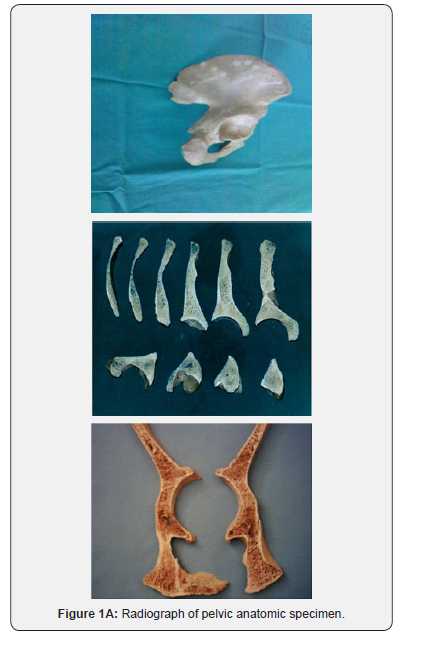

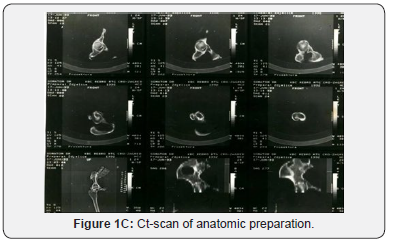



We have cut the same anatomical preparations in a transversal (cross section), longitudinal and oblique sections at a thickness of 1 cm (Tables 1 & 2a), and these prepared are x-rayed, photographed and furthermore analysed the corticaland the spongy bone structure of these specimens. 2). The 600 panoramic pelvic x-rays that have been taken from different healthy and unhealthy persons at a different age (10 months up to 90 years), have been analysed to confirm the shape and direction of the pelvic trabecular pattern (Table 2b & 2c) & (Figure 1D).


Result
The architecture of the spongy bone trabecular pattern of the pelvis and femur as well as the osteocytes which forms the unit of the trabecular are the result of the dynamic force load [4]. According to this, when we mention the spongious building of the pelvis we must consider the functional building in addition to the static effect [5,6]. On morphological analysis of preparations involving x-rayed sections of CT scan section, we found the following groups of trajectories directions (Figure 2).
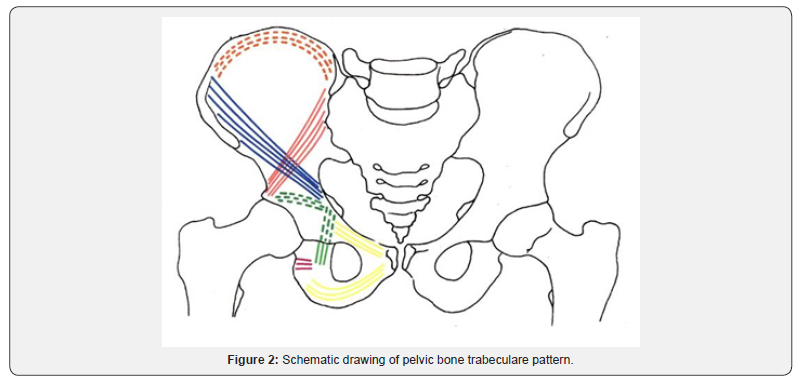
i. Medial trabeculae; is the strongest and the most appeared trabeculae of the pelvis. This form of the trabeculae starts from the faces auricular of the sacroiliac joint, directed medio - laterally and ends on the upper and lateral edge of the acetabulum [7].
ii. Lateral trabeculae; is divided into main and accessory trabeculae.
a) The main trabeculae are considered as the second in a strength and appearance of the pelvis trabeculae. They are starting from anterior superior and inferior iliac spines laterally, then directed medially to the medial and superior acetabular surface to end there, at 0-0.5 cm above the ischiadical spine (Figures 3-7).
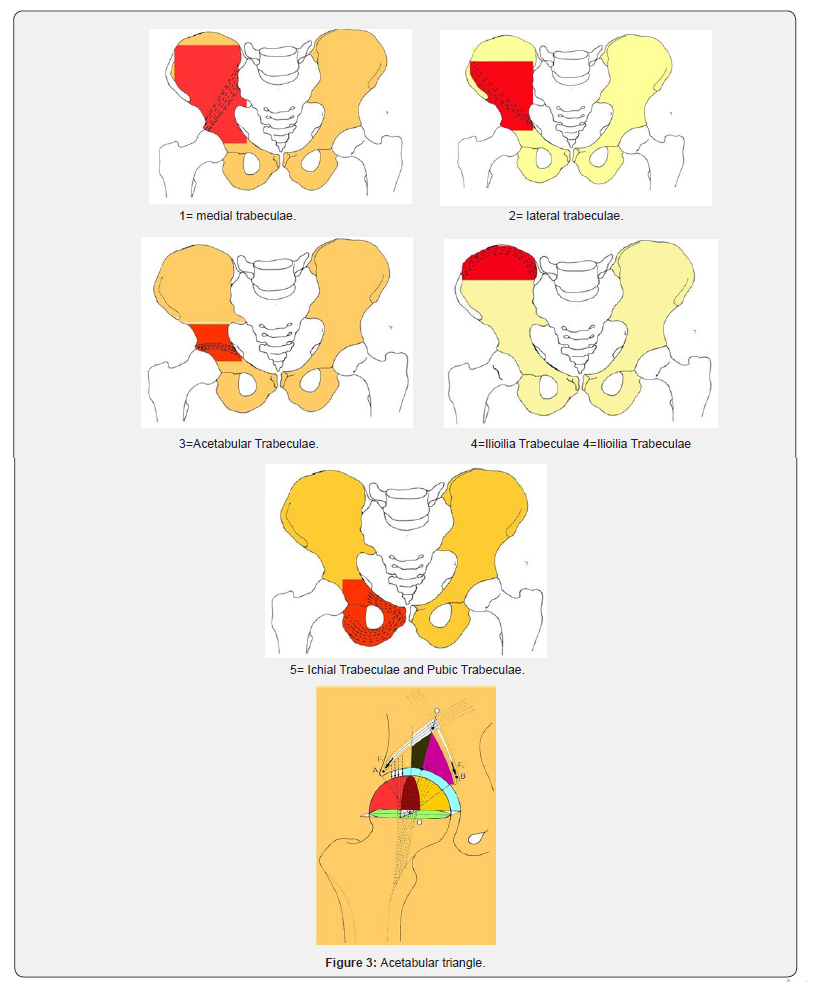
b) The accessory trabeculae; they are starting from the anterior superior and inferior iliac spines and directed perpendicularly to the lateral and superior end of the acetabulum where the medial trabeculae end.
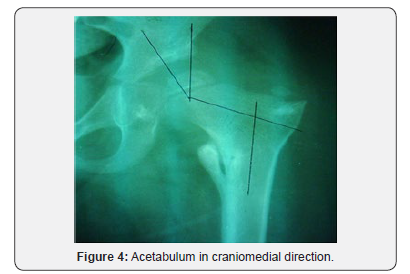
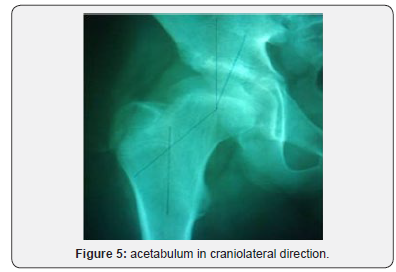
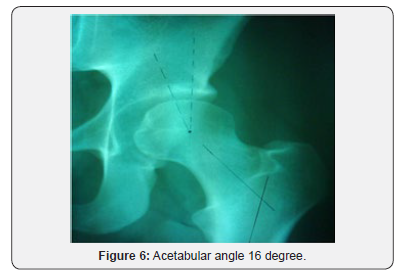
The medial and the lateral trabeculae are crossing above the acetabulum and with its roof forming a triangle. According to Bombelli the base of the triangle is to form by the weight bearing surface (WBS) of the acetabulum [1]. On A-P x-ray of the pelvis and x-ray of the sections which have been performed the length of the base of the triangle was found to be longer than the Bombelli’s idea and we found that its extended between the ends of the medial and lateral trabeculae.
iii. Acetabular trabeculae; have a curved direction (semicircular) between the medial and lateral trabeculae.
iv. Ilioiliac trabeculae; have the same direction as in the iliac crest, starts between superior posterior iliac spine and faces acetabularis medial and ended at the anterior superior iliac spine laterally.
v. Ischial trabeculae; are divided into main and accessory.
a) Main trabeculae; starts from the ischial spine where the lateral trabeculae end and extends down words through the ischial body and ramus.
b) Accessory trabeculae; is starting from the posteroinferior part of the acetabulum and then directed through the ischial body to the ischial tuber to be united with the main trabeculae to form the united ischial trabeculae, which will end in the symphysis pubis.
vi. Pubic trabeculae: are starting from the anterior part of the acetabulum and directed along the superior and inferior pubic rami to be ended at the symphysis pubic.
The general form of the pelvic trabeculae looks like a Figure 8. Inside of it there are another forms of the number 8. The biggest figure 8 of the pelvic trabeculae is formed by iliac trabeculae; acetabular and both medial and lateral trabeculae superior, as well as ischial and pubic trabeculae inferior, the smallest figure of number 8 is formed by both medial and lateral trabeculae, as well as iliac and acetabular trabeculae [8-12].
Discussion
By understanding the direction and shape of the pelvic bone trabeculae we can apply this understanding in the clinical assessment of the diseased and healthy persons, especially in cases of osteoporosis, or degenerative arthritis of the hip joint and vertebrae. Architectural building of the femoral proximal part and pelvic trajectories pattern is resulted from compressive and tensile forces effect which is transmitted by one to another. X-ray and CT-scan analysis of the pelvic bone, as well as the two and three dimensional analysis show that the trabecular pattern of pelvic bone has an important role in biomechanical transmission of load, our study show that, there is two main trabecular pattern: medial and lateral (compressive and tensile), which transmit the force acetabulum to femur and otherwise. Jacob et al. [1] show the same direction and magnitudes of the principal stresses as in our study.
Our study show that, the compressive trabecular pattern(medial), and the tensile (lateral) are crossing above the acetabulum and with its roof forming a triangle (Figure 3), according to R. Bombelli [6] the base of the triangle is to form by the weight bearing surface (WBS) of the acetabulum. Any change in the shape and direction of the pelvic bone trabecular pattern can result in changing of the acetabular triangle position (“Gothic arch” according to Bombelli [6].
Our results show that the position of the triangle is in craniomedial direction in cases of secondary coxarthritis (acetabulardysphasia, lunation, and sublimation of the hip joint) (Figure 4), while in cases of primary coxarthritis ,the position of the acetabular triangle is in crania-lateral direction (Figure 5). From these results we can conclude that the compressive and tensile trabecular pattern must be in equilibrium in condition of normal hip joint. This study show that the tensile and compressive trabeculae crossing above the acetabulum and with it make a triangle ,the angle which formed by triangle apex and femoral head center with vertical line is between 12-16 degree in healthy normal persons (Figure 6), according to Pauwels the resulting loading force is 16 degree, and from 0-12degree in patient with primary arthritis of hip joint (Figure 7), but it more than 16 degree in patient with secondary arthritis (Figure 8).

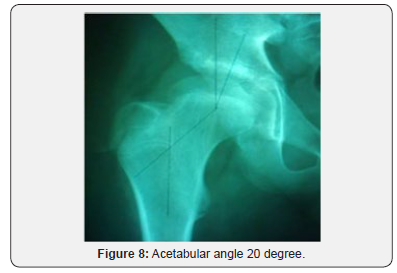
When erect, body weight and any extrinsic loading of the upper body are transmitted from L5 to the sacral base, the sacroiliac joints, ilia, and ischia. Impact forces from below arise from the foot through the tibia and femur. These axial forces meet at the acetabulum and are essentially dissipated transversely to be absorbed by the cartilage and ligaments of the hip joint, sacroiliac joints, symphysis pubis, and the sponges of pelvic bone. The gross effect is locking of the involved joints by opposing forces traveling around each side of the pelvis anteriorly and posteriori from the acetabulum [5]. According to Newtonian principles, if these axial forces (compressive and tensile) are not equalized, the pelvis cannot be in a state of equilibrium. Whenthe force from below is greater, the head of the femur tends to jam within the acetabulum. If the force from above is greater, the L5 and S1 endplates or sacroiliac joints tends to displace [5].
Niles J Holm [11] make a two –dimensional stress- optical model in which the stress patterns of the bone could be reproduced. The examination of the trabecular structure revealed that the most complete and characteristic trabecular pattern was found in a near vertical section through the acetabular joint surface parallel to the plane of Os lei ,i.e. at an angle of about 45 to the frontal plane ,that’s the same direction as in our study [6]. The pelvic bone is usually characterized as a so-called sandwich construction ,in which the bulk of the load is carried by thin shells of a high-modulus material ,while a low –weight core material acts as a spacer Jacob et al. [1]; Dalstra & Huiskes [2] show that the transfer of the hip force take place predominantly narrow tip along the anterior /superior edge of the acetabulum, because of this load transfer at the edge of the acetabulum ,the lateral shell of the iliac cortex ,just above the acetabulum and extending towards the incisura ischiadiaca major region, is heavily stressed ,according to our study the medial trabeculaer pattern take place at the anterior/superior edge of acetabulum. The acetabular triangle as well as the angle which formed by triangle and femoral center with vertical line it’s a step of investigation for more understanding the biomechanics of pelvis an
References
- Jacob HAC, Huggler AH, Dietschi C, Schreiber A (1976) Mechanical function of subchondal bone as experimentally determined on the acetabulum of the human pelvis. J Biomechanics 9(10): 625-627.
- Dalstra M, Huiskes R (1995) Load transfer across the pelvic bone. J Biomechanics 28(6): 715-724.
- Finaly JB, Bourne RB, Landsberg PD, Andreae P (1986) Pelvic stresses in vitro I. malsizing of endoprostheses. J Biomechanics 19: 703-714.
- Ries M, Pugh J, AU JC, Gurtoski J, Dee R (1989) Cortical pelvis strains with varying size hemiarthroplasty in vitro. J Biomechanics 22(8-9): 775-780.
- Carter DR, Vasu R, Harris WH (1982) Stress distributions in the acetabular region _II. Effects of cement tkickness and metal backing of the total hip acetabular component. J Biomechanics 15(3): 165-170.
- Bombelli R (1983) Osteoaethritis of the hip. (2nd ed), Springier- Overflag, Berlin- Heidelberg- NewYork, p. 23-25.
- Koch J C (1917) The laws of bone architecture . Am J Anatomy 21: 117-298.
- Nikolic V, Ruszkowski I, Vuletic A (1970) Investigations of the trabeculae of the proximal part of the femur and its mechanical relation to the epiphyscal cartilage in growth. Acta med Jug 24: 213-230.
- Pauwels F (1980) Biomechanic of the locomotor apparatus . Springier –Verleg, Berlin- Heidelberg, Newyork pp. 55-60.
- Schafer RC (1991) Clinical Biomechanics. (2nd), Williams & Wilkins, Baltimore, London. Los Angeles Sydney pp. 471-482.
- Niles J Holm (1981) The development of a two-dimensional stress –optical model of the Os coxae. Acta Orthop Scand 52(2): 135-143.
- Letournel EL, Judet R (1981) Fracture of acetabulum. Springier Verlag, Berlin-Heidelberg, New York, p. 1-25.






























